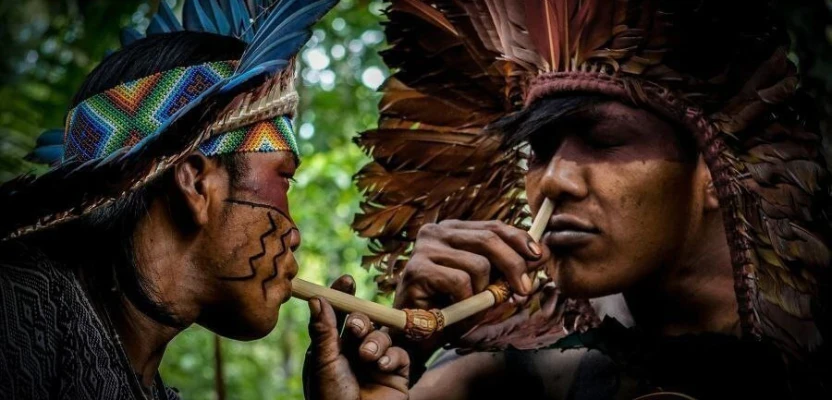
Rapé - a drug, a mixture to expand consciousness or something else?
If you're into shamanic medicine and ayahuasca ceremonies, you've probably heard of rapé. For the uninitiated, the procedure may appear strange and unusual: one blows something into the nose of another using a tube.
Rapé is a snuff traditionally used by the Amazon Valley Indians. It is a requirement of shamanic medicine and is associated with cultural heritage.
It's a fine powder, almost like dust. The color ranges from gray to yellow-sand. Nicotiana rustica ceremonial tobacco and wood ash are used to make the traditional rapé. I must state right away that rapé is made with a completely different tobacco than that used to make cigarettes or cigars. Unlike Westerners, Indians do not smoke it like that. Tobacco is a sacred plant for South American shamans. It is used in ceremonies to predict the weather or harvest, as well as for healing and spiritual growth.
Each shaman, like ayahuasca, has his or her own rapé recipe. Nicotiana rustica comes in a variety of forms, including Corda, Moi, and Mapacho. Rapé can cause dizziness because all of these species are stronger than cigarette Nicotiana tabacum. And under certain conditions, even alter the state of consciousness.
Ash, obtained from the bark of sacred trees, is the second most important component of rapé. Some Indians add extra ingredients like guarana. This type of rapé will behave similarly to coffee or a natural energy drink. Additionally, medicinal and aromatic plants may be included in the composition.
To make rapé, tobacco is first cut and dried. Then it is mixed with other components and ground in a special mortar. The resulting mixture is sifted through a fine mesh. The remaining pieces are sent back to the mortar and ground. Rapé is stored in bottles and tightly sealed tubes.
Ceremony of consuming rapé
Although rapé is referred to as a snuff, it is not simply inhaled. Rapé is forced into the nostrils with a special tube: a V-shaped kuripe for self-use or a tepi for partner blowing. The first time you use rape, it can be quite harsh and unpleasant. The mixture infiltrates deeply, and the body is unprepared for such an unexpected invasion.
It is preferable to begin rapé acquaintance with an experienced partner. Each rapé reception is a mini-ceremony where participants exchange energy. The powder blowing binds you with an invisible thread. As a result, it is critical to fully trust your partner because he will send you a particle of his spirit and intention via tepi.
A type of air strike occurs during the rapé ceremony, which focuses the mind and stops the internal dialogue. Thoughts seem to fade away, leaving only a blissful emptiness. Rapé does not produce visions or hallucinations like ayahuasca, but the state of consciousness does change: it evens out and becomes clearer.
Rapé is used by shamans to clear energy channels, connect with and strengthen their higher selves. The combination heals diseases on all levels of being, including spiritual, emotional, physical, and vibrational. Rapé effectively cleanses toxins and can be used as an additional tool in ayahuasca ceremonies, particularly if the body is overburdened with harmful substances. It aids in the treatment of colds, stimulates brain activity, and improves concentration and intuition.
Rapé is practically a panacea for all ills among Indians. It is used to treat ulcers and wounds, to repel insects, and as an anesthetic. Rapé is thought to have antibacterial properties, relieve fatigue, and suppress hunger and thirst.




Comments 0